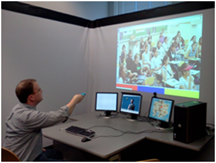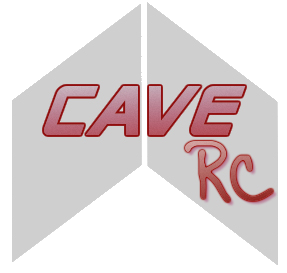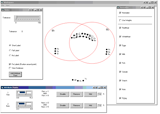Technology Assisted Review with Iterative Classification
 Manually extracting information from large text-oriented datasets can be impractical, and language variations in the text can defy simple keyword-driven
searches. This suggests the need for an intermediate approach that would allow for a technology assisted review of the documents. This project explores the
impact of keeping the human in the loop in the early stages of data mining efforts to help direct the outcome. The research team developed a tool to allow
users to interactively classify individual pages of a large text document and feed the results into a learning algorithm. As the algorithm's predictive accuracy
improves, it continually assumes a more informed role in selecting text segments for the human to evaluate until it is reliable enough to finish the classification
task unsupervised. We expect that the incremental training approach can efficiently identify a core set of data, and believe it shows promise in this
kind of application.
Manually extracting information from large text-oriented datasets can be impractical, and language variations in the text can defy simple keyword-driven
searches. This suggests the need for an intermediate approach that would allow for a technology assisted review of the documents. This project explores the
impact of keeping the human in the loop in the early stages of data mining efforts to help direct the outcome. The research team developed a tool to allow
users to interactively classify individual pages of a large text document and feed the results into a learning algorithm. As the algorithm's predictive accuracy
improves, it continually assumes a more informed role in selecting text segments for the human to evaluate until it is reliable enough to finish the classification
task unsupervised. We expect that the incremental training approach can efficiently identify a core set of data, and believe it shows promise in this
kind of application.
Collaboration Strategies for Drag-and-Drop Interactions with Multiple Devices
 ManyMouse is a software tool that revisits the ability of multiple users to collaborate by connecting their personal independent mouse hardware to a shared computer. This tool, implemented at the system level, assigns each input device to its own simulated mouse cursor, extending the potential for collaboration to any application. ManyMouse is currently being used as a platform to explore various coordination strategies and assess their impact on learning potential. Previous work on this topic has largely focused on inferring a group’s intention from the relative positioning of the mouse pointers. This work attempts to extend those ideas to include coordination of direct actions such as drag-and-drop.
ManyMouse is a software tool that revisits the ability of multiple users to collaborate by connecting their personal independent mouse hardware to a shared computer. This tool, implemented at the system level, assigns each input device to its own simulated mouse cursor, extending the potential for collaboration to any application. ManyMouse is currently being used as a platform to explore various coordination strategies and assess their impact on learning potential. Previous work on this topic has largely focused on inferring a group’s intention from the relative positioning of the mouse pointers. This work attempts to extend those ideas to include coordination of direct actions such as drag-and-drop.
Beginning and Advanced CS for Teachers
 CS4HS is an annual grant program from Google that
promotes computer science education worldwide by connecting educators to the skills and resources they need
to teach computer science.
CS4HS is an annual grant program from Google that
promotes computer science education worldwide by connecting educators to the skills and resources they need
to teach computer science.
This project invovled the design and delivery of online materials to learn about computing
concepts through the lens of Mobile App Development. Participants engaged in several small-scale app development
projects that modeled a progression of skills for their students to learn.
Materials for this course can be found at:
https://uni-cs4hs-appinventor.appspot.com/preview
Raw videos for the course are also accessible on You tube:
https://www.youtube.com/channel/UCbZR4YmCn9EYlz5D_voO-Ig/videos
Shared Display Interaction with Mobile Devices
 Traditional clicker systems typically interpret responses as
data to be stored and aggregated, then visualized as a graph. This research attempts to harness the
flexibility of the smartphone to shift this approach. Instead of interpreting student input as data, student
responses can be treated as instructions, allowing students to collectively manipulate a shared display.
For this study, CICS has been expanded to support the ability to manipulate the cursor's movement using a
smartphone to simulate a remote trackpad.
Traditional clicker systems typically interpret responses as
data to be stored and aggregated, then visualized as a graph. This research attempts to harness the
flexibility of the smartphone to shift this approach. Instead of interpreting student input as data, student
responses can be treated as instructions, allowing students to collectively manipulate a shared display.
For this study, CICS has been expanded to support the ability to manipulate the cursor's movement using a
smartphone to simulate a remote trackpad.
The goal of this study was to better understand how a collaborative influence impacts the performance of
simple tasks like cursor movement and selection. To objectively measure the performance of this technique,
multiple users will be asked to participate in a series of Fitts Selection Tasks. The results suggest
that it is possible for multiple users to collaboratively move a single pointer without significant degradation
in performance.
Software Promoted Interaction in Speech-Language Therapy
 Semantic Feature Analysis is a speech-language treatment that is frequently used with individuals who have
suffered strokes or brain injuries and who demonstrate difficulty accessing the words they wish to say. The
focus of this treatment, as with many kinds of speech-language therapy, is the interaction that takes place
between the clinician and the patient.
Semantic Feature Analysis is a speech-language treatment that is frequently used with individuals who have
suffered strokes or brain injuries and who demonstrate difficulty accessing the words they wish to say. The
focus of this treatment, as with many kinds of speech-language therapy, is the interaction that takes place
between the clinician and the patient.
With the rapidly expanding use of technology, many clinicians in medical settings are exploring ways to
incorporate new tools into their therapy sessions. The emergence of mobile and handheld technologies is
particularly appealing because of their collaborative potential. The ability for a patient and speech-language
pathologist to engage in Semantic Feature Analysis through a shared tablet or other shared display would not
only expand the range and accessibility of test items, it could also facilitate the record-keeping tasks of
the clinician. More importantly, as a shared display, the essential quality of the exercise - interaction
between the participants - is preserved in a way that cannot be done with a traditional desktop device.
Classroom Collaboration with Mobile Devices
 One of the major perceived barriers to the adoption of Classroom Response Systems, a.k.a. "clickers",
is limited interactivity. Students using dedicated clicker hardware are often only able to provide
basic multiple choice or simple numeric responses. The accessibility and flexibility of smartphones
make them an intriguing platform for managing some of the shortfalls of traditional classroom response
systems. This approach not only leverages a resource that a growing number of students already own,
but also aims to enhance the effectiveness of the system by tapping into the robust interaction capabilities
that these devices afford.
One of the major perceived barriers to the adoption of Classroom Response Systems, a.k.a. "clickers",
is limited interactivity. Students using dedicated clicker hardware are often only able to provide
basic multiple choice or simple numeric responses. The accessibility and flexibility of smartphones
make them an intriguing platform for managing some of the shortfalls of traditional classroom response
systems. This approach not only leverages a resource that a growing number of students already own,
but also aims to enhance the effectiveness of the system by tapping into the robust interaction capabilities
that these devices afford.

Virtual Puppetry
This project explores virtual puppetry as a potential mechanism for enhancing students' presence in a virtual learning environment.
To develop this style of interaction requires substantial attention to the user interface in order to promote the operator's (puppeteer's)
situation awareness of both the real and virtual environments. This project developed of an initial prototype and identified
some of the ongoing concerns for controlling virtual puppets.

CaveRC
Large, multi-screen displays can be used to foster a sense of immersion in a virtual environment, which in turn leads to better transfer and retention of spatial information. This project seeks to isolate the underlying factors that contribute to the sense of presence that viewers feel when interacting with this type of display.
Behavioral Queries
 This research explores "Behavioral Based Visual Queries" to balance the objectivity of query languages and the rapid insight afforded
through visualization. In this model, each row of a database table is represented by a visual data avatar that is programmed with
certain behaviors. Users can specify queries by using familiar interface components to introduce stimuli to a collection of avatars.
As each avatar reacts to the stimuli and other avatars, emergent behaviors can be interpreted as a query result.
This research explores "Behavioral Based Visual Queries" to balance the objectivity of query languages and the rapid insight afforded
through visualization. In this model, each row of a database table is represented by a visual data avatar that is programmed with
certain behaviors. Users can specify queries by using familiar interface components to introduce stimuli to a collection of avatars.
As each avatar reacts to the stimuli and other avatars, emergent behaviors can be interpreted as a query result.
Attentive Navigation
 The ability to manipulate the viewpoint is critical to many tasks performed in virtual environments (VEs). However, viewers in an
information-rich VE are particularly susceptible to superfluous data and are easily distracted. Attentive Navigation techniques can
address this issue by allowing the viewer to explore freely while allowing the system to suggest optimal locations and orientations.
This provides a supportive yet unscripted exploration of a Virtual Environment.
The ability to manipulate the viewpoint is critical to many tasks performed in virtual environments (VEs). However, viewers in an
information-rich VE are particularly susceptible to superfluous data and are easily distracted. Attentive Navigation techniques can
address this issue by allowing the viewer to explore freely while allowing the system to suggest optimal locations and orientations.
This provides a supportive yet unscripted exploration of a Virtual Environment.
